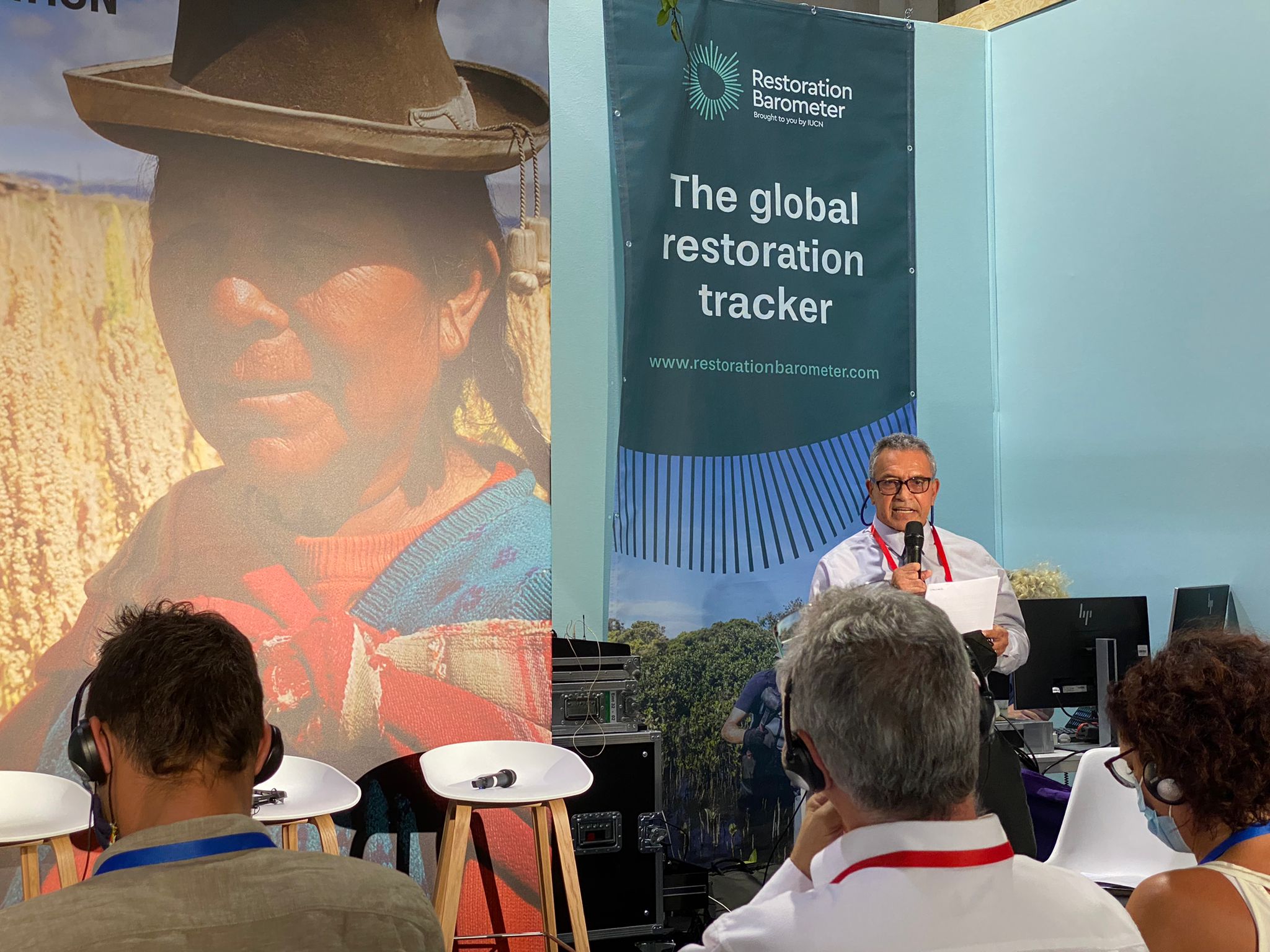Restoring ecosystems part-and-parcel of IUCN Congress
During the Expo of the IUCN World Conservation Congress, the Nature-based Solutions and Ecosystem Restoration pavilion devoted over half of its programme to restoration work as part of the UN Decade of Ecosystem Restoration. Hosting events that drew from an extensive network of restoration knowledge, providing new tools for implementation and inspiring uptake of restoration work.

Photo: IUCN
Sharing existing initiatives
Learning from the past was a prevalent notion throughout the sessions on ecosystem restoration. They took us across the world to demonstrate current restoration interventions and explore restoration potential from wetlands to urban environments.
Restoration for multiple benefits at the landscape level was illustrated in a session on enhancing water security in urban and rural areas of Central America (video). In this session, case studies from Guatemala, Honduras and Panama displayed how tools such as the Restoration opportunities assessment methodology (ROAM) that prioritise areas, actions, and investments can be used for policy decision-making. Furthering the focus on water, a session on wetland restoration (video) showed how vital wetland ecosystems are for our common future and drew upon examples of where successful wetland restoration has taken place with a view to inspire and scale up such efforts. The Partners for Wetlands - WWF, BirdLife International, Wetlands International, the Wildfowl & Wetlands Trust, the International Water Management Institute, and IUCN - committed to boost their support for the Ramsar Convention in protecting and restoring wetlands during the coming decade.
The inclusion of stakeholders across all levels in the restoration process is paramount. At the Restoration Implementation Showcase (video), the Rwandan Ministry of Environment reminded us that, “if we don’t include the local community, we will never see the impact on the ground.” While representatives from El Salvador discussed the essential cooperation between agricultural and environmental sectors in developing agri-environmental priorities.
Multiple sessions referred to the issues surrounding the mismatch of timeframes between funding and restoration. Critical issues were raised by the audience, such as the inadequacy of short-term financing, while speakers reflected upon the challenge of how to sustain progress once projects withdraw. The Restoration Initiative (video) showed how they are catalysing action by partnering with strategic players to develop a mutually beneficial approach tailored to scale and needs. One of their goals is to demonstrate that finance for restoration is often available and can be accessed with the correct setup. For local Nature-based Solutions interventions and private enterprises, the aim is to make projects “finance-ready” and increase investments. Similarly, the Alliance for Restoration of Forest Ecosystems in Africa (video) seeks to improve large-scale forest landscape restoration’s economic, environmental, and climate benefits for key stakeholders in partner countries.
 Photo: IUCN
Tools
Photo: IUCN
Tools
 Photo: IUCN
Photo: IUCN
A tenet of the UN Decade on Ecosystem Restoration is the role that everyone can play, from governments and businesses to farmers and others. Many sessions at the pavilion explained or even launched tools to assist implementation on the ground.
To support bottom-up initiatives at the community level, a focus group session asked participants to provide feedback on the upcoming IUCN toolkit for community organising. For practitioners, at the science-based action and enhancing capacities for ecosystem restoration (video) event, UN Decade on Ecosystem Restoration consortium partners released the 10 Principles for Ecosystem Restoration and shared a science-based ecosystem restoration think piece, both developed to aid in restoration planning. While the IUCN hosted a session on Restoring Ecosystems Using Risk-assessment Science (video), which uses the Red List of Ecosystems to identify and plan restoration actions by assessing how driving threats are impacting risk.
Representatives from a regional network across six African countries presented how ecosystem accounting for natural capital (video) allows for the non-monetary valuation of ecosystems from Earth observation data. Directly contributing to the implementation and monitoring of the post-2020 biodiversity agenda and UN Decade on Ecosystem Restoration.
Tools also included how we can use technology to ensure more transparent and inclusive restoration actions with stakeholders. Keys to improving forest landscape restoration outcomes (video) showed us how tools like the Global Disruptive Tech challenge helped generate innovative ideas for ecosystem restoration. In Scaling FLR implementation through technology (video), cases were presented on how technology can help attract restoration investment, improve monitoring and strengthen local governance. This session also marked the official launch of FLR chain, a blockchain-powered application designed to maximise incentives and reduce risks of investing in forest landscape restoration.
Future restoration initiatives
Celebrating a commitment to the Bonn Challenge (video) brought us announcements that pushed total Bonn Challenge pledges to over 213 million hectares worldwide. France Region Sud, the Congress host region, pledged to restore 1.6 million hectares. This is the second pledge to come from Western Europe and is sure to inspire other countries in the region. An additional one million hectares pledge came from Pakistan, building on a previous provincial pledge that was fully implemented and has provided a model for scaling-up restoration across the nation. Chile and Honduras both announced recent Bonn Challenge pledges by video, and the Minister from Belize pledged 130,000 hectares in an inspiring speech citing the usefulness of the ROAM assessment in this decision.
 Photo: IUCN
Photo: IUCN
During the session, the GEF CEO Carlos Manuel Rodrigues made the poignant remark that “restoration is about bringing nature back and luckily we still have some untouched nature left, but if we remain on the current trajectory, my children, your children, the next generation may not have the luxury in even debating this, there will only be restoration work left.”
Looking ahead, over 40 countries have endorsed the Restoration Barometer to track progress on their Bonn Challenge pledges. IUCN is now pleased to extend the Barometer to all terrestrial and coastal ecosystems to help track progress toward the UN Decade on Ecosystem Restoration. An updated web portal will follow later this year as a key tool to help all of us achieve our ecosystem restoration aspirations.
—Webstory by Eleanor Moore, Doctoral Student at Newcastle University, UK



